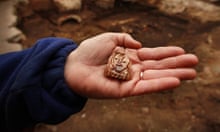For many people he is the round-headed bald man seen on the First Folio of his collected works but evidence was presented yesterday arguing that we should rethink this. Instead we should visualise Shakespeare as a rosy-cheeked, long-nosed man who was something of a looker.
New research revealed yesterday contends that the only portrait of Shakespeare painted in his lifetime has been found. Debates about the real image of Shakespeare often get mired in complicated, art historical detail, but Professor Stanley Wells, one of the world's leading Shakespeare experts, announced in London he was 90% certain the portrait is that of the playwright.
Also, the story of the painting - known as the Cobbe portrait - once again raises questions about Shakespeare's sexuality. Was he more than just good friends with the man who commissioned the painting, his patron the Earl of Southampton?
Yesterday, the Shakespeare Birthplace Trust chose the grand Mayfair base of the English Speaking Union to unveil what they are convinced is the only authentic image of Shakespeare made from life. The trust's director, Diana Owen, called it a "momentous, historical and fascinating event".
The painting has hung on the walls of properties owned by the Cobbe family for about 300 years. The sitter has always been unknown, although there was an erroneous thought that it might be Sir Walter Raleigh.
In 2002, art restorer Alec Cobbe, joint heir of the Cobbe estate, was at the National Portrait Gallery's Searching for Shakespeare exhibition and came upon a painting known as the Folger portrait, which itself, until 70 years ago, had been thought to be a life portrait of Shakespeare. The similarities between the two were obvious and Cobbe rang Wells immediately, setting in motion more than two years of extensive art historical, literary and scientific research.
The result is the firm belief that the Folger painting is a copy of the Cobbe original. It is also likely to have been used by the teenage engraver who produced one of the most recognisable of Shakespeare images - the copper engraving of a bald, round-headed man on the First Folio of Shakespeare's plays, published in 1623.
That the painting looks more like a 26-year-old than a 46-year-old - Shakespeare's age when it was likely painted - may be down to the convention of the time when a painter should "polish out the wrinkles and increase the size of the pearls," according to Mark Broch, curator of the Cobbe collection. It seems likely the Earl of Southampton commissioned the Cobbe portrait, emphasising once more his closeness to Shakespeare.
Over the years there have been many false alarms on images of Shakespeare, including the Chandos portrait in the National Portrait Gallery. Even experts at the gallery doubt its authenticity.
The Cobbe portrait will be at the centre of an exhibition trying to unravel the intrigue that will open at The Shakespeare Birthplace Trust in Stratford-on-Avon on 23 April.





